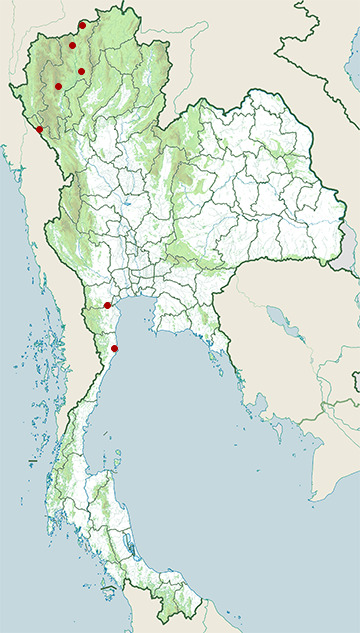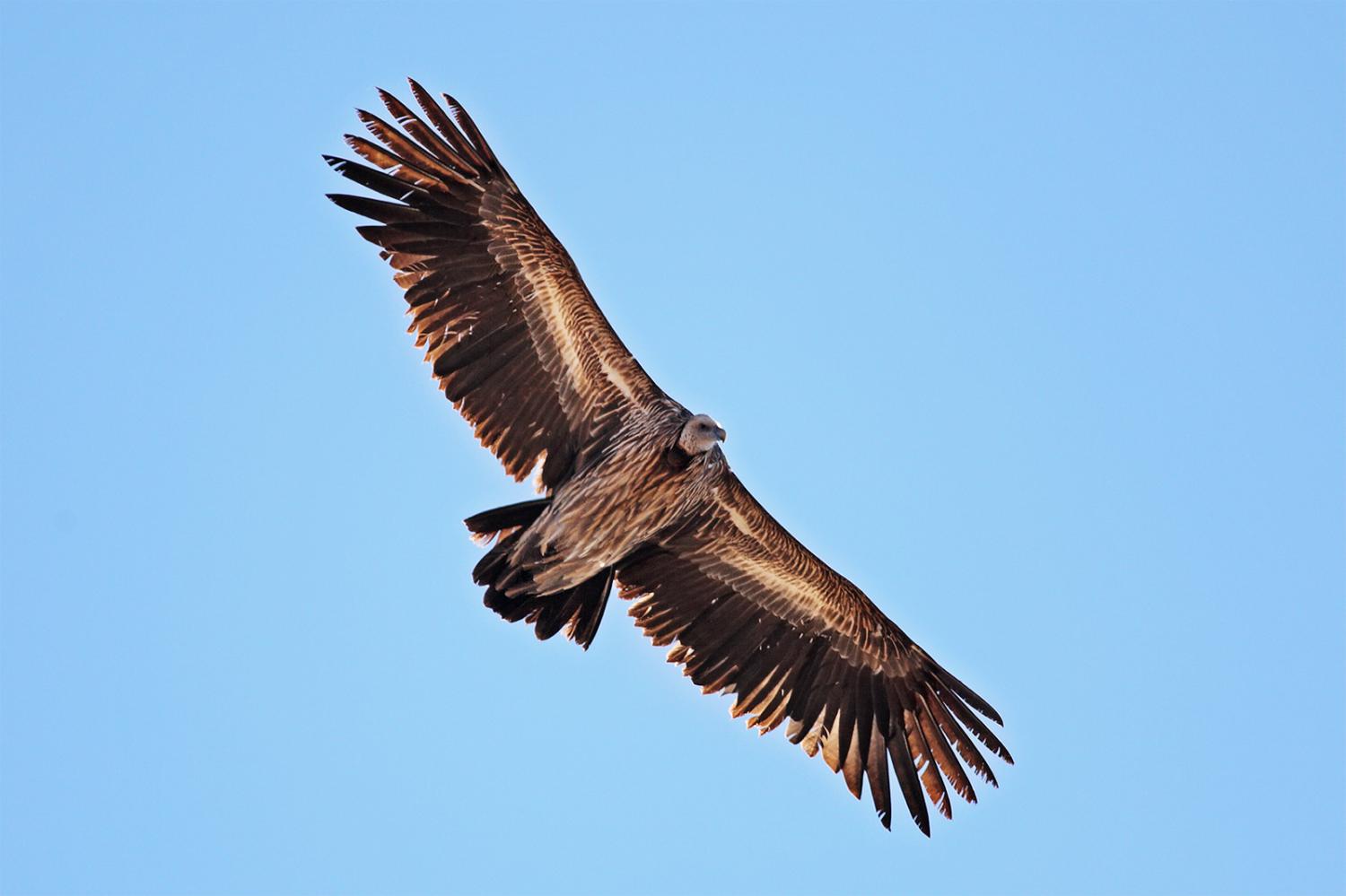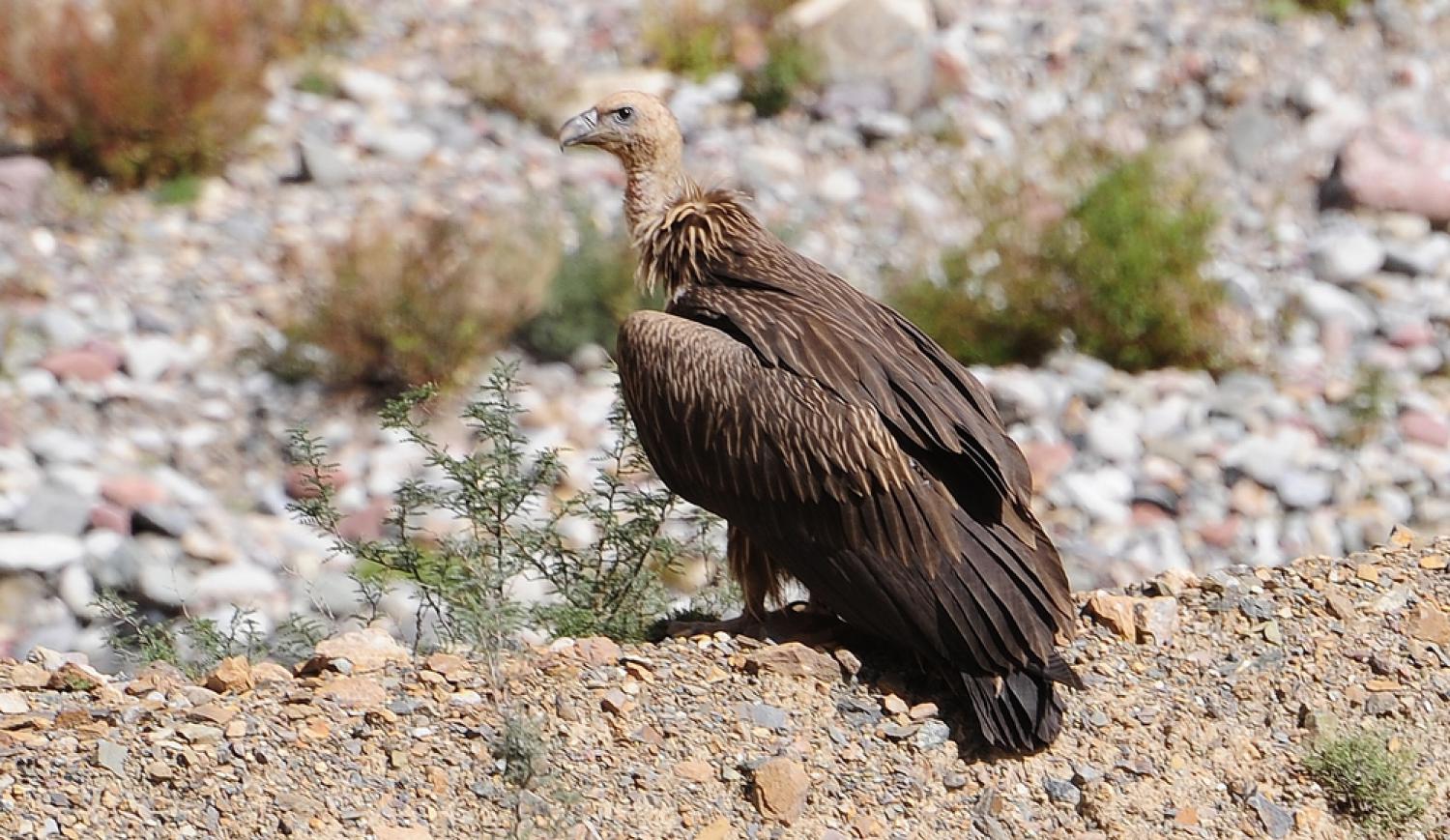Species of Thailand
Himalayan griffon vulture
Gyps himalayensis
Allan Octavian Hume, 1869
In Thai: อีแร้งสีน้ำตาลหิมาลัย
The Himalayan vulture (Gyps himalayensis) or Himalayan griffon vulture is an Old World vulture native to the Himalayas and the adjoining Tibetan Plateau. It is one of the two largest Old World vultures and true raptors. It is listed as Near Threatened on the IUCN Red List.
Description
This is a huge vulture, and is perhaps the largest and heaviest bird found in the Himalayas. It is the largest of the species in the Gyps genus, seemingly averaging larger in every method of measurement than its relatives. Adults have a ruff that is long and pale brown with white streaks. The ruff feathers are long and spiky. The head is covered in down which is yellowish in adults but whitish in immature vultures. The underside and under-wing coverts are quite pale brown or buff, being almost white in some specimens. The legs are covered with buffy feathers and the feet can vary from greenish grey to white. The upperside is unstreaked, pale buff with the tail quills, outer greater coverts and wing quills being a contrasting dark brown. The inner-secondaries have paler tips.
The pale blue facial skin is lighter than the dark blue in Gyps fulvus with this species having a yellowish bill. In flight the long fingers are splayed and there is a pale patagial stripe on the underwing. The wing and tail feathers are dark and contrast with the pale coverts and body, one of the best methods to distinguish this species from the slightly smaller griffon vulture. The feathers on the body have pale shaft streaks. They are distinguished from the Indian vulture (G. indicus), which can somewhat similar in color by being much larger with a stouter, more robust bill. Younger birds have a pale parts to the bill and tend to have buffy-white streaks on the scapulars and wing coverts contrasting with dark brown underparts. They are similar in size to the cinereous vulture (Aegypius monachus), which has a slightly shorter overall length but in large specimens can weigh more than the Himalayan vulture. Weight in Himalayan vultures can range from reportedly as little as 6 kg lb abbr=on to as much as 12.5 kg lb abbr=on. A field study estimated an average of 9 kg lb abbr=on for the Himalayan vulture, but weights can vary with conditions from 8 - 12 kg lb abbr=on. The wingspan of birds varies greatly depending on the method used to measure them and published measurements vary from 2.56 to 3.1 m ft abbr=on, a similar wingspan range as a cinereous vulture.
Distribution
The Himalayan vulture lives mainly in the higher regions of the Himalayas, the Pamirs, Kazakhstan and on the Tibetan Plateau, with northwestern limits of the breeding range being in Afghanistan and southern limits in Bhutan. Juvenile birds may however disperse further south, and vagrants have been recorded in Thailand, Burma, Singapore and Cambodia.
Diet
The Himalayan vulture perches on crags, favourite sites showing white marks from regular defecation. They tend to not range below an elevation of 1215 m ft abbr=on. Himalayan vultures often bask in the sun on rocks. They soar in thermals and are not capable of sustained flapping flight. Flocks may follow grazers up the mountains in their search for dead animals. This vulture makes a rattling sound when descending on a carcass and can grunt or hiss at roosts or when feeding on carrion. They have been recorded eating carrion exclusively, some which is fed on even when putrid. On the Tibetan Plateau 64% of their diet is obtained from dead domestic yak (Bos grunniens). They feed on old carcasses sometimes waiting a couple of days near a dead animal. They disdain offal, which is readily eaten by other vultures, and instead typically eat only fleshy parts. Historically, Himalayan vultures regularly fed on human corpses left out on Celestial burial grounds. This species is fairly contentious around other scavengers and typically dominates other meat-eaters at carrion, though is subservient to gray wolves (Canis lupus), snow leopards (Panthera uncia) and cinereous vultures at carcasses. In a large party, these vultures can reportedly strip a human or sheep carcass of all meat in 30 minutes and do the same to a yak carcass in roughly 120 minutes. Himalayan vultures have been observed feeding on pine (Pinus roxburghii) needles, an unexplained behaviour that cannot be for obtaining nutrition.
Breeding
The breeding season begins in January. The nest is a platform of sticks placed on an inaccessible ledge on a cliff. Nest in northeastern India have been recorded at between 1215 and 1820 m ft abbr=on in elevation, but those in Tibet have been as high as 4245 m ft abbr=on. Several pairs may nest on the same cliff face, with between five and seven pairs being a typical colony size. The nests are relatively small for the large size of these birds and, although grow larger with repeated uses, do not generally get as massive as the nest of other large accipitrids. There is at least one recorded instance of Himalayan vultures using a nest made by bearded vultures (Gypaetus barbatus). On the Tibetan Plateau, Himalayan and bearded vultures were observed nesting in close proximity without conflict, which is notable because in several other cases of adjacent interspecies nesting by Old World vultures (including some involving bearded vultures) have resulted in high aggression and interspecies attacks. A single white egg marked with red splotches is the usual clutch. Egg laying dates in northern India have ranged from December 25 to March 7. The egg is coarse and oval and can measure from 87 to 103.6 mm in abbr=on in height and 65 to 74 mm in abbr=on in width, with an average of 94.8 by 70.1 mm in abbr=on. In captivity the incubation period was about 54–58 days. The young birds stay on with the parents for six to seven months.
Threats
Himalayan vultures are susceptible to toxicity induced by diclofenac, a drug whose residues in domestic animal carcasses has led to rapid declines in populations of other Gyps vultures across Asia. The Himalayan griffon vulture populations have however not shown signs of rapid decline although reductions in nesting birds have been noted in some parts of its range in Nepal.
This article uses material from Wikipedia released under the Creative Commons Attribution-Share-Alike Licence 3.0. Eventual photos shown in this page may or may not be from Wikipedia, please see the license details for photos in photo by-lines.
Category / Seasonal Status
Wiki listed status (concerning Thai population): Accidental
BCST Category: Recorded in an apparently wild state within the last 50 years
BCST Seasonal status: Non-breeding visitor
Scientific classification
- Kingdom
- Animalia
- Phylum
- Chordata
- Class
- Aves
- Order
- Accipitriformes
- Family
- Accipitridae
- Genus
- Gyps
- Species
- Gyps himalayensis
Common names
- Thai: อีแร้งสีน้ำตาลหิมาลัย
Conservation status

Near Threatened (IUCN3.1)

Near Threatened (BirdLife)

Near Threatened (ONEP)

Near Threatened (BCST)
Photos
Please help us review the bird photos if wrong ones are used. We can be reached via our contact us page.
Range Map

- Chiang Dao District, Chiang Mai
- Doi Inthanon National Park
- Doi Pha Hom Pok National Park
- Doi Saket District, Chiang Mai
- Khao Sam Roi Yot National Park
- Khao Yoi District, Phetchaburi
- Mae Moei National Park



